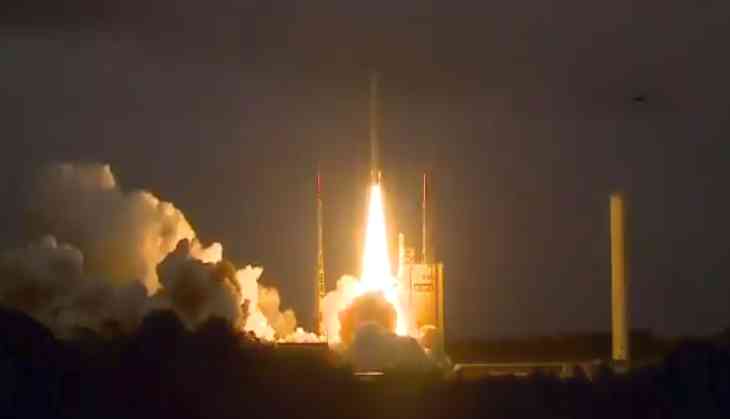India successfully launches latest communication satellite GSAT-31

India's latest communication satellite GSAT-31 was successfully launched by European launch services provider- Arianespace rocket from French Guiana in the early hours of Wednesday.
Blasting off from Ariane Launch Complex at Kourou, a French territory located in northeastern coast of South America at at 02:31 am (IST), the Ariane-5 vehicle injected GSAT-31 into the orbit in a flawless flight lasting about 42 minutes.
"It gives me great pleasure on the successful launch of GSAT-31 spacecraft on board Ariane-5, this is the third mission for ISRO in 2019," Indian Space Research Organisation's (ISRO) Satish Dhawan Space Centre (SDSC) Director S Pandian said at Kourou soon after the launch.
"Congratulation to Arianespace on the successful launch and precise injection of satellite into the orbit," he added.
Arianespace CEO Stphane Isral tweeted: "2019 is off to a roaring start for #Arianespace! Flight #VA247, carrying Saudi Geostationary Satellite 1/Hellas Sat 4 and GSAT-31, is a confirmed success that underscores our leadership position in the geostationary launch market. @KACST #HellasSat @ISRO @LockheedMartin."
Weighing about 2,535 kg, the GSAT-31 will provide continuity to operational services on some of the in-orbit satellites.
The satellite derives its heritage from ISROs earlier INSAT/GSAT satellite series, the space agency said, adding that it provides Indian mainland and island coverage.
GSAT-31 is the country's 40th communication satellite which is configured on ISRO's enhanced 'I-2K Bus', utilising the maximum "bus capabilities" of this type.
This satellite will augment the Ku-band transponder capacity in Geostationary Orbit, ISRO said.
With a mission life of around 15 years, GSAT-31 will be used for supporting VSAT networks, Television uplinks, Digital Satellite News Gathering, DTH-television services, cellular backhaul connectivity and many such applications.
It also provides wide beam coverage to facilitate communication over large oceanic region, comprising large parts of Arabian Sea, Bay of Bengal and Indian Ocean, using a wide band transponder.
According to ISRO, two Ku-band beacon downlink signals are transmitted for ground tracking purpose.
The Ariane-5 vehicle (Flight VA247) also carried Saudi Geostationary Satellite 1/Hellas Sat 4 along with GSAT-31.
Riding in Ariane 5's upper position, HS-4/SGS-1 was released first in the flight sequence, with its separation occurring about 27 minutes after liftoff.
Comprising two payloads, Saudi Geostationary Satellite 1/Hellas Sat 4, also called HS- 4/SGS-1, is a geostationary condosat for KACST (King Abdulaziz City for Science and Technology Saudi Arabia) and Hellas Sat (Greece Cyprus).
HS- 4/SGS-1 will provide telecommunication capabilities, including television, Internet, telephone and secure communications in the Middle East, South Africa and Europe, Arianespace said on its website.
GSAT-30 is another geostationary satellite to be lofted soon by Arianespace. Since the launch of India's APPLE experimental satellite on Ariane Flight L03 in 1981, Arianespace has orbited 23 satellites and signed 24 launch contracts with the Indian space agency, the European launch services provider said .
-PTI






![BJP's Kapil Mishra recreates Shankar Mahadevan’s ‘Breathless’ song to highlight Delhi pollution [WATCH] BJP's Kapil Mishra recreates Shankar Mahadevan’s ‘Breathless’ song to highlight Delhi pollution [WATCH]](http://images.catchnews.com/upload/2022/11/03/kapil-mishra_240884_300x172.png)

![Anupam Kher shares pictures of his toned body on 67th birthday [MUST SEE] Anupam Kher shares pictures of his toned body on 67th birthday [MUST SEE]](http://images.catchnews.com/upload/2022/03/07/Anupam_kher_231145_300x172.jpg)






